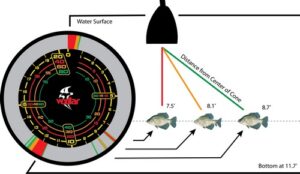Using Your Vexilar to the Fullest
By: Matt Johnson
We’re all familiar with 3-color flashers. We’ve used them for years and they
what’s below you and react accordingly is something most of us would never
forfeit. It’s to the point now that if we leave our Vexilar at home then we turn
around to get it. Fishing is just not the same without your flasher staring you in
the face when battling with a finicky fish. But do we really use our Vexilar to its
fullest? It’s not just a tool that shows the bottom, the fish and your jig, it’s much
more than that…
Whether it’s an FL-8, FL-18, FL-12 or FL-20, your Vexilar has fast become
your best friend on the ice. Seeing that green flicker turn into an orange line
followed by a solid red blip drives tingles down every watcher. Then when it
results in a solid thump only to have a plate-sized bluegill on the ice moments
later do we realize how exciting, and important our Vexilar becomes. Seeing
the fish in relation to your presentation is more than half the battle, but using
your Vexilar to determine the fish’s mood can drastically change the way you
put fish on the ice. Understanding how a fish reacts to various jigging
movements can help boost your success rate. For example, things like when to
slow down, when to speed up or when to do nothing at all. These are all things
we need to pick up on when using our Vexilars.
Fish are simple creatures. They need to eat to survive and like humans they
go through various feeding patterns and variances in appetites. When a fish
comes in fast only to stop abruptly and leave your offering alone we need to
then evaluate the situation and decide that the jigging action was important,
but the appeal/look of the presentation needs a minor adjustment. You called
the fish in with action, but once the fish got a look at what was moving it
decided to shut its mouth. Changing color, upsizing or downsizing, adding
scent… these are a few ideas in which to increase your triggering power in this
situation. Case in point, watching the fish’s behavior on your Vexilar allows you
to take out some of the guesswork and make changes based on how fish react
to what you’re doing. Don’t just settle for the old saying, “fish are down there
but they just aren’t biting.” Be smarter than that; use your Vexilar to help you
make your next move.

We all know that the stronger the signal the more red the line becomes… but
what about determining the size of the fish? Or better yet, the direction a fish is
facing or whether or not that fish is aggressive or negative? Your Vexilar can
tell you these things. Of course the obvious is to assume the larger red blips
are larger fish, and this would sometimes turn out to be true. However, fish with
larger air bladders will also show up as larger marks. This is the reason why
jumbo perch show up as large blips, because we all know that those jumbos
have air bladders the size of golf balls. Larger gamefish like pike and walleyes
have larger air bladders than panfish, but what we’re also seeing is the orange
and green marks of the fish’s “extremities.” What I mean is, the longer the fish,
the more potential there is for a change in signal. As those larger fish move,
the transducer picks up on those movements and shoots back orange and
green lines surrounding your once single, solid red line. This oftentimes looks
like more than one fish if Mr. Pike is on the prowl, but as you pay closer
attention you will realize that those red lines are “stretching” and not
separating. Fish that change body position to a more vertical posture will give
off those stretching characteristics, so when those sometimes pesky pike rise
to check out our tiny ice jig that is why we see a larger red line. Telling the size
of a fish is possible with your Vexilar, so don’t listen to grandpa.
Determining the aggressive level of the fish is also easy to do with your
Vexilar. The obvious is simple, when a fish flies in and crushes your bait then
you have an aggressive fish. OK, you got me there. But when you have fish
that decide to swim in slow but constantly “quiver” then I wouldn’t throw out the
aggressive card just yet. Just because a fish doesn’t slam the bait doesn’t
mean it’s not aggressive. Watching your Vexilar and picking up on those short
rapid movements can tell us that we have a fish that wants to eat, we just need
to find out what that desired menu item is. Then on the flip-side we have those
fish that slowly rise to the bait, seem as if they are motionless, and then slide
away. Those would be our negative fish and it might be time to find a new spot.
Determining whether or not the fish under you are aggressive or negative can
save on frustration and valuable fishing time.
What about the idea of reading below the bottom? Sounds ludicrous I know,
but not impossible. In fact, it’s very doable and important when targeting
bottom-hugging fish. This phenomenon is made simple by watching what is
below your “actual bottom.” Movements below the bottom indicate fish coming
out of weeds or fish that are off to one side where the bottom depth is slightly
deeper in one spot. I can assure you that the bottom is not moving with the
intent of teasing you, but rather because a fish is starting to build up the
ambition to soon attack what you’re offering. Next time you’re on the ice pay
attention to what your bottom is doing, you’ll be surprised just how much
activity goes on that you might have ignored.
Have you ever thought of the idea that weeds are really our friends? I know it’s
important to focus on green weeds when available, but what I’m referring to is
having the ability to use either Low Power mode or the S-Cable to see through
the weeds. While fishing in thick weeds we oftentimes throw in the towel
because we can’t see our jig… but let’s take a lesson from Rocky and not give
up without a fight. Switching to Low Power mode cuts your watts from 400 to
200 and allows us to drastically cut down on the amount of weeds we pick up
on our Vexilars. By adjusting our sensitivity we can soon find out that not only
can we see our jig, but we are successfully targeting and catching fish
amongst the once overlooked weed flats. Ask me where my favorite areas to
fish on the lake are and I’m going to the weeds, and having the ability to fish
the weeds helps solidify my decision.
These are just a few simple ideas to add new ways to interpreting your Vexilar.
The idea here is to not always just look at things at face value. Step outside
the box and use your Vexilar as not just a fish indicator, but rather a learning
tool that will teach you a lot more than you know about the underwater world. If
you get a chance to use your Vexilar in coordination with an underwater
camera then you can see exactly how fish react and what sort of signal you’re
receiving. Sight fishing is another way to build confidence in what your Vexilar
is telling you.
Understanding the mood of the fish will help you decide what to throw next.
Understanding the size of the fish you are targeting can make your decision to
move easier. Understanding how to effectively fish thick weeds can pay off with
great rewards. Understanding how to use your Vexilar to the fullest will help
make you a better ice angler. Turning the unit on is only the first step, but by
the time you turn it off make sure you got the most out of what that underwater
world has to offer!
